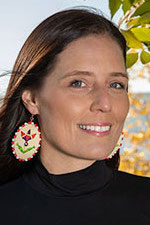Helping Indigenous Elderly Plan for the Future
By Jena Pierce on
It is always hard to think about the end of life, and often, those discussions are not in line with culture in Indigenous communities. This can leave questions if someone is incapacitated or suffers a major medical event, and family members, loved ones, and caretakers may not know how decisions should be made.

"When you look at tribal communities," explained Tasha Peltier, community engagement advocate for Quality Health Associates of North Dakota, "some of us are still navigating the impacts of colonization and the historical trauma that came with it. In dealing with these issues, it can be difficult to think about things down the road. Many of our Elders are functioning in survival mode. What do I need to do today to make sure my needs, or my family's needs are met? Planning for the future is a privilege not all of our people have. They can't necessarily plan for what to do when they get sick or are in that transition. When you are consumed with how you will eat, or pay your bills, planning for the future tends to fall off the list."
Written Decisions
With the goal of helping Indigenous elderly, the National Indigenous Elder Justice Initiative (NIEJI) (no longer available online) at the Center for Rural Health (CRH), within the University of North Dakota School of Medicine & Health Sciences, has developed a new product: My Advance Care Plan & Guide for Native Americans. The guide is to assist these individuals in planning for health issues and end-of-life decisions, and helping to share their wishes with their care team and loved ones.
The culturally-appropriate guide is intended to help encourage discussions and assist people with putting their wishes into writing.
"One of the things that will play into how this plan will be used depends on their understanding of the issues," said Peltier. "In healthcare, health literacy is something we focus on. Making sure the patient understands the information we are giving them. This tool will be helpful because a person may not know what information they should be thinking about or writing down. This asks the questions and guides them through the process. It outlines what things people should be talking about. Often people just don't know where to start and that can be overwhelming."
We wanted to be sure this was not only culturally-appropriate, but also respects the different traditions and values of the various tribes/bands/clans throughout the country."
Sections of the guide include:
- What is important to you now
- How you like to make decisions
- What care and treatment you would like in the future
- What is important to you after your death
"I saw a similar guide developed by the Māori, the Indigenous people of Aotearoa (New Zealand)," said Dr. Jacque Gray, director of NIEJI.

"I felt this could be a valuable tool for many of our Elders and their families, and received permission to adapt it for the Indigenous peoples throughout the United States."
Gray continued, "We wanted to be sure this was not only culturally-appropriate, but also respects the different traditions and values of the various tribes/bands/clans throughout the country. We chose language and images that would help members of all tribes feel more comfortable while thinking about difficult situations."
Transcending Tribes
The guide asks individuals to think about who they want making medical decisions on their behalf, if they are unable to do so. It also talks about subjects such as:

- What worries them about the future
- What type of medical care they prefer (medicine/treatment)
- What environment they wish to spend their end of life in
- How they want to be laid to rest. It also respects those where it is counter to culture to speak of future death and dying.
Peltier noted, "The different language being used is helpful, looking at a spiritual journey or death. That language matters and it is helpful to have that incorporated into this plan. I am from Standing Rock Tribal Nation, and we see death as a transition, we are all on a path and death is a transition to the next part of our journey. Not every tribe looks at it the same way, so I think those pieces are important."
Encouraging Important Discussion
Peltier received a draft of the plan in 2021 and was able to share with Indian Health Service providers as they worked on an age-friendly project, looking at the care being provided to geriatric patients and finding ways they can provide better care. The plan fit within the scope of the project and the feedback from the providers has been positive.
"As far as the content and what it looks like, the providers think it is great," said Peltier. "But they do not have the time to go through the plan with a patient during an appointment. So we discussed who would have the time to go through this with the patient and we created a process to refer the patient to a social worker in the facility, who can take the time to walk the individual through the plan. However, this is still a work in progress and we know there are barriers to be addressed. For example, coming back to the facility for another appointment may be difficult, due to transportation constraints. Bringing it home and working through it with family is an option, not ideal but still an option."
Who Helps Make Decisions?
The plan is not a legal document, but discusses when it may be appropriate to appoint an enduring power of attorney (EPOA), or someone who legally may make medical decisions and should be included in any discussions about future care and treatment options. If there is no EPOA, there is a space for the individual to write down who they would like to be asked to make decisions.
Our kinship looks very different. It is not the typical nuclear family that may be making these decisions.
"Tools like these are helpful, especially when you have multiple family members," said Peltier. "Indigenous people have big, extended families. Our kinship looks very different. It is not the typical nuclear family that may be making these decisions. When a parent passes away, an auntie or uncle step into that role. We have a different way of identifying our kinship and these roles are strong and important."
She continued, "When you are looking at who should be making decisions, sometimes that looks different. Who in that tight-knit family will be making those decisions? It might not be a son or daughter. It might be a niece or nephew. It can get complex. They may be the oldest in that family. Having documents like this to help make the decisions is beneficial. Even to outline who should be making these decisions can be helpful."

CRH works with tribal communities to help improve health outcomes and well-being for American Indians, and assists to bring awareness to, and prevent, elder abuse through the work of NIEJI.
"The Center of Rural Health is focused on helping Indigenous Elders live healthier lives," said Brad Gibbens, acting director of CRH. "Having the ability to encourage individuals to take control of their health and end-of-life decisions and make their wishes known, is something we are proud to be a part of."
For More Information
The My Advance Care Plan & Guide for Native Americans is available online.


 is the communications manager at the Center for Rural
Health at the University of North Dakota School of
Medicine & Health Sciences in Grand Forks.
is the communications manager at the Center for Rural
Health at the University of North Dakota School of
Medicine & Health Sciences in Grand Forks.



